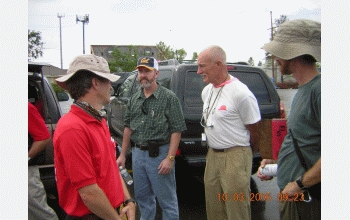All Images
News Release 05-190
Researchers to Present Findings on New Orleans Levee Breaches
Details of preliminary results to be released
This material is available primarily for archival purposes. Telephone numbers or other contact information may be out of date; please see current contact information at media contacts.

American Society of Civil Engineers geotechnical-team members inspect a portion of the floodwall along the Industrial Canal that was overtopped and flattened by Katrina's storm surge. The force of the storm shattered much of the concrete wall that topped the steel sheet-piles.
Credit: Rune Storesund photos
Download the high-resolution JPG version of the image. (440 KB)
Use your mouse to right-click (Mac users may need to Ctrl-click) the link above and choose the option that will save the file or target to your computer.

University of Berkeley researchers Ray Seed (in baseball cap) and Bob Bea (hatless) prepare to investigate the New Orleans levees with colleagues from the American Society of Civil Engineers and the Army Corps of Engineers.
Credit: Rune Storesund photos
Download the high-resolution JPG version of the image. (369 KB)
Use your mouse to right-click (Mac users may need to Ctrl-click) the link above and choose the option that will save the file or target to your computer.

This concrete floodwall and its steel-pile anchors were originally sunk into the levee top along New Orleans' Industrial Canal. The structures were devastated by the force of Hurricane Katrina's storm surge, allowing water to flood the city's Lower Ninth Ward. Berkeley engineers examined damaged and destroyed levees and floodwalls during a weeklong visit to New Orleans in October, and will soon present formal recommendations based on their findings.
Credit: Rune Storesund photos
Download the high-resolution JPG version of the image. (441 KB)
Use your mouse to right-click (Mac users may need to Ctrl-click) the link above and choose the option that will save the file or target to your computer.


